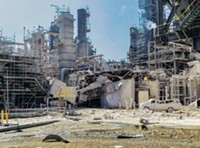Advertisement
Grab your lab coat. Let's get started
Welcome!
Welcome!
Create an account below to get 6 C&EN articles per month, receive newsletters and more - all free.
It seems this is your first time logging in online. Please enter the following information to continue.
As an ACS member you automatically get access to this site. All we need is few more details to create your reading experience.
Not you? Sign in with a different account.
Not you? Sign in with a different account.
ERROR 1
ERROR 1
ERROR 2
ERROR 2
ERROR 2
ERROR 2
ERROR 2
Password and Confirm password must match.
If you have an ACS member number, please enter it here so we can link this account to your membership. (optional)
ERROR 2
ACS values your privacy. By submitting your information, you are gaining access to C&EN and subscribing to our weekly newsletter. We use the information you provide to make your reading experience better, and we will never sell your data to third party members.
Safety
Hydrofluoric Acid Safety
Recurring hydrofluoric acid leaks at Texas Citgo refinery draw chemical safety board attention
by Jeff Johnson
April 2, 2012
| A version of this story appeared in
Volume 90, Issue 14

A series of hydrofluoric acid (HF) leaks at a Citgo refinery in Corpus Christi, Texas, is being investigated by the Chemical Safety & Hazard Investigation Board (CSB). No one was injured, but the leaks signal a continuing problem with HF at the plant, CSB team lead Johnnie Banks said when announcing the investigation on March 16.
HF is used as an alkylation catalyst to manufacture high-octane fuels. About one-third—some 50—of the nation’s refineries use the acid, which is corrosive and highly toxic as well as a contact poison that burns skin, tissue, and eyes and can cause death. CSB data show that several refinery accidents it is or has investigated involved HF.
Citgo has a history of problems with HF. The recent troubles started last September when a series of small HF leaks from a 12-inch flange at the plant’s alkylation unit occurred. On March 5, a larger leak of 300 to 500 lb triggered plant sensors, kicked off water cannons designed to capture airborne HF, and brought Citgo’s ongoing HF problems to the board’s attention, CSB said.
The flange leaks continued, and the water cannons were again activated on March 10 and 11, according to CSB. The additional releases were small, Banks said, but CSB is concerned that refinery management is growing to accept water cannon use as a routine control for leaks, rather than seeing the cannons as the “last line of defense.”
Previously, this same Citgo refinery experienced an accident and intense fire that injured two workers and resulted in the release of 4,000 lb of HF from the alkylation unit, according to CSB. The board began an investigation following this July 2009 accident. Although CSB has yet to complete its investigation, the board issued several urgent recommendations to Citgo in December 2009. It also announced a program to study refinery accidents because of the sector’s safety problems.
Despite this history, Citgo officials said in a statement following the recent HF leaks that the company is “a recognized safety leader in the refinery industry,” while providing jobs and tax revenues to the Corpus Christi community. Citgo also noted that no fire resulted from the recent incidents and said improvements put in place since 2009 “helped our refinery team and the local fire department respond quickly and ensure the safety of our workers and our neighbors.”
Citgo’s accident—and now leaks—is one of several refinery accidents CSB is investigating. In fact, seven of 14 ongoing CSB investigations are of refinery accidents and, like its investigation of Citgo, many are several years old. The delay, the board said in its annual budget request to Congress, is due to an ever-growing workload and years of flat congressional appropriations (C&EN, March 12, page 48).
Meanwhile, HF-related accidents have brought about pressure from labor unions and community groups to find replacements for HF and its associated technology.
Over the next few weeks, the United Steelworkers (USW) will release the results of a union member safety survey of refinery plant practices involving HF, says Michael J. Wright, the union’s director of health, safety, and environment. USW is urging refiners to shift away from both HF and sulfuric acid, which is also used as an alkylation catalyst, and to explore solid-state catalysts and other alternatives.
A solid-acid alkylation technology to replace HF is being developed by New Jersey-based Exelus with funding from the Department of Energy and the National Science Foundation’s Small Business Innovation Research Program. Exelus President Mitrajit Mukherjee says the firm is talking with U.S. refiners to demonstrate the technology on a small 4- to 5-barrel-per-day unit.
Wright notes the potentially large impact of accidents at refineries where HF is used and points to a March 6 explosion at a Valero Energy refinery in Memphis in which one worker was killed and two were badly burned. That accident did not involve HF, but the plant uses and stores large quantities of the acid. If HF had been released, it could have affected more than 700,000 people living near the facility.
CSB has decided not to investigate the Valero accident, Wright says, but the union has petitioned the board to reconsider. USW has also written to senators and representatives from Tennessee and Arkansas, calling on them to urge CSB to do an investigation.
“CSB has declined due to its backlog of investigations and lack of resources,” Wright says, “and we understand that.” However, Wright stresses that CSB has made “the wrong decision.”
The Valero accident will be investigated by state industrial officials, but Wright points out that Valero is the state’s only refinery. He is concerned that unlike CSB, the state lacks experience to conduct a quality refinery accident investigation. He adds that the recent fatal accident is the refinery’s third serious fire in less than two years.
In an e-mail to C&EN, CSB confirmed that it will not investigate Valero. Last year, the board investigated only a handful of 282 accidents that met its legally defined threshold for investigation.




Join the conversation
Contact the reporter
Submit a Letter to the Editor for publication
Engage with us on Twitter